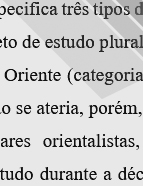

Overlapping with the field of operations of the Society of Jesus and with key moments in the history of Portugal’s maritime expansion, the main geographical and thematic focuses addressed by Portuguese orientalists include Portuguese India (sometimes compared with the former jewel in Portugal’s imperial crown, Brazil, notably in the works of António Lopes Mendes), North Africa, Macau and, less commonly, Jewish and Hebrew culture (as in the works of Joshua E. Levy, Mendes dos Remédios, Joseph Benoliel, and Samuel Schwarz), China (see the lexicographical works of Father Joaquim Afonso Gonçalves) and Japan. Timor also gained a certain visibility in the 1950s, after the Japanese occupation of the island was broken and the collapse of the Portuguese colonial project was beginning to look like a foregone conclusion. However, the linguistic interests of Portuguese orientalists reached beyond the borders of these spaces of influence and actually neglected languages which were essential to the construction of the Portuguese empire in the East, namely Chinese and Japanese. Portuguese orientalists studied Ethio-Semitic philologies which, in addition to Sanskrit and Arabic, included Hebrew and Gǝʿǝz, a preference that reflected Europe’s nineteenth-century interests. On occasion, other Oriental languages, such as Malay or Tamil, were also discussed in the context of comparative philology. Nonetheless, it was perhaps the interest shown in the languages of Portuguese India, particularly Konkani (a living language) and the overseas Creoles, which determined the specificity of the Oriental philology practised in Portugal. Although, on the one hand, the languages that the Portuguese had come into contact with were studied, on the other, many orientalists preferred to focus on the Portuguese language itself, studying its circulation, its interactions with Oriental languages and the Creoles that resulted from these exchanges, a predilection which, once again, amounted to studying the history of Portugal’s expansion and influence in Asia. This attempt to recover the memory of Portuguese in Oriental languages, and vice-versa, underlines the continued relevance of the observation made by Nebrija in his Arte de grammatica de lengua castellana (Salamanca, 1492), that language was the loyal companion of empire (and faith).
As already discussed, the Portuguese historiography practised from the end of the nineteenth century was attuned with efforts to situate the roots of Portuguese orientalism in the sixteenth century, which Sousa Viterbo described as “unquestionably, a vast and valuable oriental museum” (O Orientalismo em Portugal no século XVI, 1893, p. 3). From the end of the nineteenth century up until the 1950s and 60s, it was this “museum” which, like a reliquary of mainly textual sources, would be catalogued, revisited and analysed by orientalists who, in this way, contributed to the kind of organization of sources required to establish any field as a respectable discipline.
